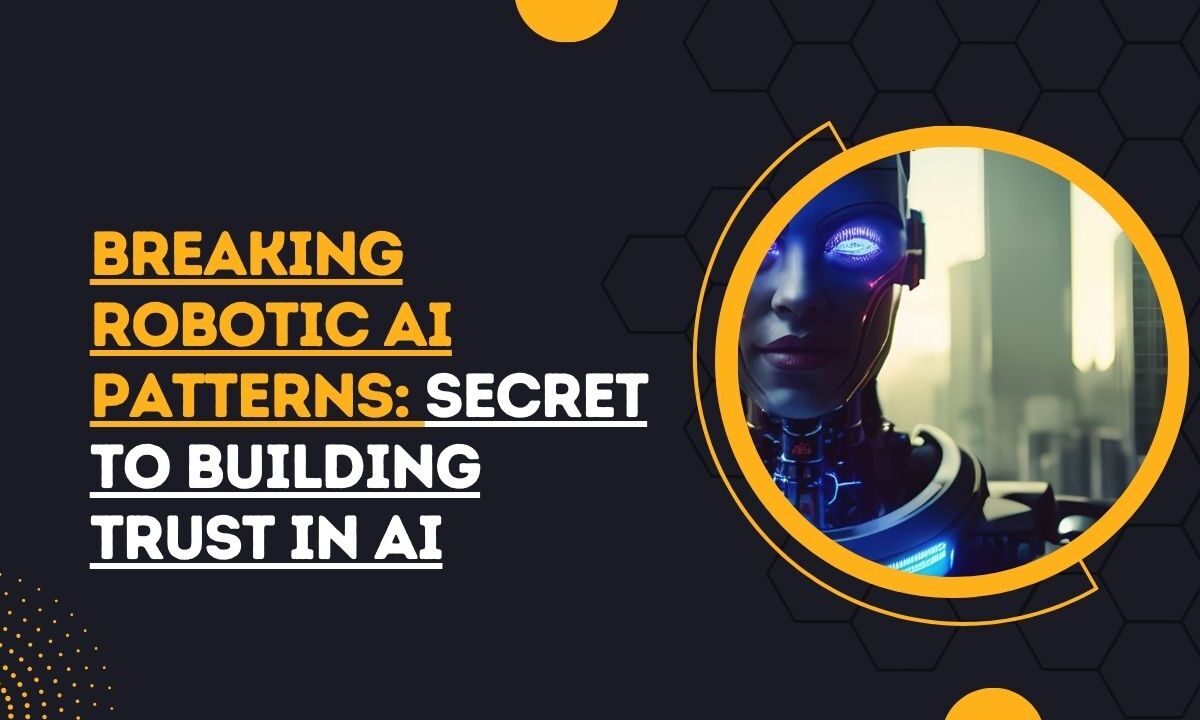Breaking Robotic AI Patterns: The Secret to Building Trust in AI
Did you know that over 40% of people feel uneasy using AI-driven technologies? Breaking robotic AI patterns is the key to turning this skepticism into trust.
With AI becoming an integral part of our daily lives, it’s crucial to make these systems more relatable, adaptive, and human-like.
In this article, we’ll explore how dismantling rigid AI behaviors can help you build a more trusting relationship with technology.
Ready to discover how AI can work for you, not against you? Keep reading, the transformation starts now.
What Are Robotic AI Patterns?
Before we can break these patterns, let’s first understand what they are.
Robotic non-human patterns in AI refer to behaviors and responses that lack the flexibility, empathy, and adaptability we typically expect from human interaction.
These patterns make AI seem rigid, impersonal, or mechanical. Here are four examples:
Rigid Decision-Making:
AI that strictly follows pre-programmed rules or algorithms without adjusting to new or unexpected situations.
For example, a customer service bot that cannot handle a unique question and defaults to a generic response.
Lack of Emotional Intelligence:
AI systems that fail to recognize or appropriately respond to human emotions.

For instance, a chatbot that doesn’t detect frustration in a user’s tone and continues offering irrelevant solutions.
Repetitive Responses:
AI that provides the same answers to similar questions without learning or adapting.
An example would be a virtual assistant giving generic responses without considering the user’s previous interactions.
Inflexibility in Learning:
AI that struggles to learn from new data or experiences.
For example, an AI system in a self-driving car that doesn’t adjust its behavior based on real-time road conditions, such as sudden weather changes.
At first, everything seems smooth, but the moment you ask something a bit unexpected; the bot freezes or gives a mechanical response.
It’s almost as if it’s thinking, “Wait, this isn’t in my programming!”
These robotic patterns can create a disconnect and foster skepticism about AI’s ability to genuinely understand and adapt to human needs.
Examples of Robotic Non-Human Patterns in AI
| Pattern | Example Statement | Explanation |
|---|---|---|
| Rigid Decision-Making | “I’m sorry, I don’t understand that request. Please follow the instructions.” | AI follows pre-set rules, unable to handle unique or complex queries. |
| Lack of Emotional Intelligence | “I can help you with that. Is there anything else?” | AI fails to detect frustration or emotion in the user’s tone, offering an impersonal response. |
| Repetitive Responses | “The answer to your question is 42.” (Repeated each time the same question is asked) | AI gives the same response without adapting or improving over time. |
| Inflexibility in Learning | “I cannot proceed because the system is not designed to handle this situation.” | AI doesn’t learn from new data, refusing to adapt to unexpected conditions. |
Why Breaking Robotic AI Patterns Matters
AI systems, despite their impressive capabilities, often lack the fluidity and empathy that we associate with human interaction.
This is where breaking robotic AI patterns becomes important.
When AI learns to go beyond these mechanical responses and adapt to human nuances, it becomes more relatable and trustworthy.
Imagine trusting a self-driving car.
If you knew it was following a rigid pattern, you’d feel uneasy.

But if the car can adapt, make decisions on its own in real-time, and account for unpredictable human behavior, you’d be far more likely to trust it.
By breaking robotic AI patterns, we allow AI to evolve in ways that make it more human-like, more reliable, and ultimately, more trustworthy.
How Can We Break Robotic AI Patterns?
So, how do we break these patterns?
Well, it’s all about rethinking the way we program AI.
Here are some strategies that are currently being used:
Incorporating Emotional Intelligence:
By introducing emotional intelligence into AI, we make systems more adaptable to human feelings.
AI that can recognize emotions, tone, and context in conversations will naturally build stronger rapport with users.
Improving Machine Learning Algorithms:
Machine learning allows AI to continuously improve and adapt.
The more diverse the data it’s exposed to, the less likely it is to rely on rigid patterns.
This flexibility is key to breaking robotic behavior.
Human-AI Collaboration:
Rather than creating systems that function in isolation, human-AI collaboration is a powerful tool.
When AI can learn from humans and vice versa, the relationship becomes dynamic, not static.
Transparency and Accountability:
One of the reasons AI can feel robotic is because its processes are hidden.
Making AI’s decision-making process more transparent can help build trust.
If we understand why an AI system makes a particular decision, we’re more likely to trust it.
The Role of AI in Our Daily Lives
AI is everywhere. From virtual assistants like Siri and Alexa to algorithms recommending movies on Netflix, AI’s presence is undeniable.
But what if these systems didn’t feel robotic?
What if every interaction felt natural, personal, and effortless?
When we break robotic AI patterns, we allow these systems to become more intuitive and effective.
Instead of repeating the same responses or relying on rigid patterns, AI will be able to truly listen and respond in ways that make sense for us.
The Psychological Impact of Breaking Robotic AI Patterns
Breaking robotic AI patterns isn’t just about improving the technology—it’s also about changing how we view AI.
Psychologically, trust is built when we feel understood.
Humans have an innate need to connect with others, and when AI systems mimic those human-like behaviors, it helps bridge the gap between machine and user.
This connection fosters trust, which in turn makes users more willing to embrace AI in more significant aspects of their lives.
Metaphorically speaking, AI can be thought of as a bridge.
But if the bridge is too rigid, users may hesitate to cross it.
When we make that bridge flexible, adaptable, and able to respond to varying conditions, more people will feel comfortable walking across.
Breaking Down the Trust-Building Process
Now that we understand the “why” and the “how,” let’s break down the process of building trust in AI through the lens of pattern-breaking.
Here’s a simple table outlining key components:
| Key Element | Traditional AI Patterns | Breaking Robotic AI Patterns |
|---|---|---|
| User Interaction | Rigid responses | Natural, adaptive responses |
| Decision-Making | Pre-programmed rules | Contextual, real-time decisions |
| Learning | Static programming | Dynamic learning from experience |
| Empathy | Limited emotional recognition | Emotional intelligence built in |
| Transparency | Opaque decisions | Clear decision-making processes |
Breaking robotic AI patterns means flipping these traditional models and embracing a more human-like approach.
This shift isn’t just theoretical—it’s happening in real-time.
The Future of AI: Breaking the Mold
The future of AI is incredibly exciting, and breaking robotic AI patterns is key to unlocking its full potential.
As AI continues to evolve, the focus will increasingly be on making these systems more adaptable, empathetic, and trustworthy.
In the coming years, we can expect AI to become more intuitive, blending seamlessly into our lives while remaining reliable and human-like.
To build trust, we must break free from the limitations of robotic patterns and embrace a more flexible, adaptive, and human-centered approach.
The more AI can adapt to our needs and understand our emotions, the more we will trust it—and the more it will revolutionize the way we live.
So, what can you do? Start noticing the AI systems around you. How human-like are they?
How adaptable?
By recognizing the importance of breaking robotic AI patterns, we can all contribute to the future of a more trustworthy and effective AI-driven world.
Transparency helps users understand how AI makes decisions, which builds trust and reduces skepticism.
FAQs
What are the most common robotic patterns in AI?
Robotic patterns in AI typically include rigid responses, lack of emotional intelligence, and limited adaptability to unexpected situations.
How can emotional intelligence improve AI?
By programming AI to recognize emotions and respond empathetically, systems become more relatable, building trust with users.
Can AI ever be as trustworthy as humans?
While AI can emulate human-like behavior, trust depends on how effectively it learns and adapts to human needs. With advancements in machine learning, AI can become increasingly reliable.
How long will it take to break robotic AI patterns?
The process is ongoing and depends on technological advances in AI development. However, incremental improvements are already being seen.
What are the risks of not breaking robotic AI patterns?
Without breaking these patterns, AI will remain impersonal and rigid, reducing its effectiveness and hindering widespread adoption.
What is the role of transparency in AI trust?
Related Posts
How AI Content Earns Our Trust One Step at a Time
AI-Generated Content: Trustworthy Innovation or Digital Deception?
Cultivating Trust in The AI Search Age: The Power of Authenticity
Maintaining Authenticity in the Age of AI: Strategies for Bloggers
Conclusion
Breaking robotic AI patterns is more than just a technical challenge—it’s an opportunity to build a better, more human-like relationship between technology and people.
By breaking robotic AI patterns, we can create systems that understand, adapt, and respond with empathy, fostering trust and collaboration.
This shift not only enhances user experience but also paves the way for smarter, more intuitive
AI that truly supports human needs. As AI becomes more integrated into our daily lives, breaking robotic patterns ensures that these systems are not just tools, but partners.
By embracing flexibility and emotional intelligence, we can create AI that feels more natural, intuitive, and aligned with human values.

